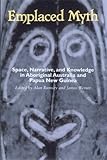Emplaced Myth : Space, Narrative, and Knowledge in Aboriginal Australia and Papua New Guinea / ed. by Alan Rumsey, James F. Weiner.
Material type: TextPublisher: Honolulu : University of Hawaii Press, [2000]Copyright date: ©2001Description: 1 online resource (289 p.)Content type:
TextPublisher: Honolulu : University of Hawaii Press, [2000]Copyright date: ©2001Description: 1 online resource (289 p.)Content type: - 9780824816636
- 9780824843946
- Aboriginal Australians -- Land tenure -- Congresses
- Aboriginal Australians -- Land tenure -- Congresses
- Papuans -- Land tenure -- Congresses
- Philosophy, Aboriginal Australian -- Congresses
- Philosophy, Papuan -- Congresses
- Sacred space -- Australia -- Congresses
- Sacred space -- Melanesia -- Congresses
- SOCIAL SCIENCE / Anthropology / Cultural & Social
- 305.89/915 21
- GN666 .E52 2001
- online - DeGruyter
- Issued also in print.
| Item type | Current library | Call number | URL | Status | Notes | Barcode | |
|---|---|---|---|---|---|---|---|
 eBook
eBook
|
Biblioteca "Angelicum" Pont. Univ. S.Tommaso d'Aquino Nuvola online | online - DeGruyter (Browse shelf(Opens below)) | Online access | Not for loan (Accesso limitato) | Accesso per gli utenti autorizzati / Access for authorized users | (dgr)9780824843946 |
Frontmatter -- Contents -- Acknowledgments -- Introduction -- 1. Tracks, Traces, and Links to Land in Aboriginal Australia, New Guinea, and Beyond -- 2. The Politics of Religious Secrecy -- 3. Condensed Mapping: Myth and the Folding of Space / Space and the Folding of Myth -- 4. Origins versus Creative Powers: The Interplay of Movement and Fixity -- 5. Sacred Site, Ancestral Clearing, and Environmental Ethics -- 6. Places That Move -- 7. Strangelove's Dilemma: Or, What Kind of Secrecy Do the Ngarrindjeri Practice? -- 8. The Underground Life of Capitalism: Space, Persons, and Money in Bali (West New Britain) -- 9. From Totemic Space to Cyberspace: Transformations in Sepik River and Aboriginal Australian Myth, Knowledge, and Art -- 10. The Object in View: Aborigines, Melanesians, and Museums -- Afterword -- References -- Contributors -- Index
restricted access online access with authorization star
http://purl.org/coar/access_right/c_16ec
Australia and Papua New Guinea share a number of important social, cultural, and historical features, making a sustained comparison between the two especially productive. This volume is the first in-depth work to do just that: it situates the ethnography of the two areas within a comparative framework and examines the relationship between indigenous systems of knowledge and "place"--an issue of growing concern to anthropologists. The essays demonstrate the manner in which regimes of restricted knowledge serve to protect and augment cultural property and the proprietorship over sites and territory; how myths evolve to explain and culturally appropriate important events pertaining to contact between indigenous and Western societies; how graphic designs and other culturally important iconic and iconographic processes provide conduits of cross-cultural appropriation between indigenous and non-indigenous societies in today's multicultural nation states.Contributors: Lissant Boltan, Andrew Lattas, Anthony Redmond, Alan Rumsey, Deborah Bird Rose, Eric Kline Silverman, Pamela J. Stewart, Andrew Strathern, Roy Wagner, Jurg Wassmann, James F. Weiner.
Issued also in print.
Mode of access: Internet via World Wide Web.
In English.
Description based on online resource; title from PDF title page (publisher's Web site, viewed 02. Mrz 2022)


